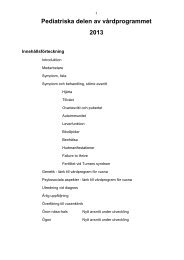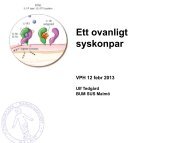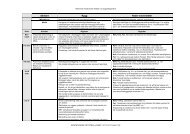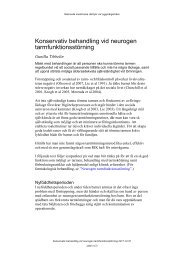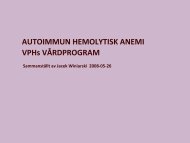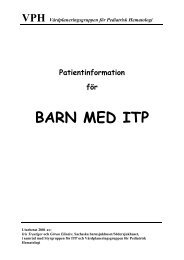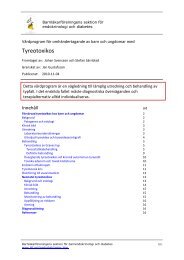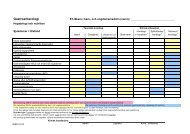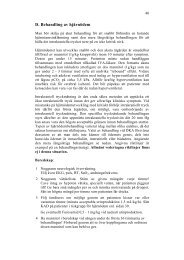Physiotherapy in children with cerebral palsy - BLF
Physiotherapy in children with cerebral palsy - BLF
Physiotherapy in children with cerebral palsy - BLF
Create successful ePaper yourself
Turn your PDF publications into a flip-book with our unique Google optimized e-Paper software.
<strong>Physiotherapy</strong> <strong>in</strong><br />
<strong>children</strong> <strong>with</strong> <strong>cerebral</strong> <strong>palsy</strong><br />
Eva Brogren Carlberg<br />
PT, Associate Professor<br />
Dept of Woman & Child Health<br />
Karol<strong>in</strong>ska Institute<br />
&<br />
Handicap & Habilitation<br />
Stockholm
Intervention for CP<br />
began<br />
mid-1940’s<br />
Initial habilitation<br />
concepts explored<br />
and ref<strong>in</strong>ed<br />
“Traditional”<br />
philosophy<br />
of habilitation<br />
1980<br />
New concepts evolved<br />
out of experience and<br />
research<br />
Contemporary<br />
philosophy<br />
of habilitation<br />
Charlene Butler, Ed. D.<br />
Seattle, USA<br />
Eva Brogren Carlberg 19 januari 2007 2
Eva Brogren Carlberg 19 januari 2007 3
Charlene Butler, Ed. D.<br />
Seattle, USA<br />
Eva Brogren Carlberg 19 januari 2007 4
Charlene Butler, Ed. D.<br />
Seattle, USA<br />
Eva Brogren Carlberg 19 januari 2007 5
Research on ambulatory capacity<br />
<strong>in</strong> CP<br />
• Never achieved by some<br />
• Loss or deterioration <strong>in</strong> many<br />
In teen age due to energy cost<br />
About age 25 - due to ’physiological burn<br />
out’<br />
About age 45 – due to jo<strong>in</strong>t deterioration<br />
and pa<strong>in</strong><br />
Eva Brogren Carlberg 19 januari 2007 6
Motor<br />
Growth<br />
Curves<br />
'Prognosis for Gross Motor Development <strong>in</strong> Cerebral Palsy.<br />
Creation of Motor Growth Curves', Rosenbaum et al., JAMA 2002; 288; 1357-63.<br />
Eva Brogren Carlberg 19 januari 2007 7
Other Conceptual Shifts<br />
• Disability movement<br />
• Model of disablement<br />
• Model of service delivery<br />
• Theory of motor control, motor<br />
development and motor learn<strong>in</strong>g<br />
• Valid and reliable measures<br />
Eva Brogren Carlberg 19 januari 2007 8
Health<br />
Body function<br />
&<br />
Body structure<br />
Activity<br />
Participation<br />
Environment<br />
Personal factors<br />
2005 Eva Brogren Carlberg<br />
Eva Brogren Carlberg 19 januari 2007 9
Participation<br />
ICF<br />
Functional problems <strong>in</strong><br />
<strong>children</strong> <strong>with</strong> CP<br />
• <strong>in</strong> daily life activities<br />
Activities<br />
• functional capacity and performance<br />
• basic motor functions<br />
Body functions and<br />
structure<br />
• postural problems<br />
• control of movements<br />
• muscle strenght<br />
• spasticity<br />
• range of motion<br />
• perception and cognition<br />
Brogren & Hadders-Algra 2005, Crenna 1998; Damiano t al. 2002, Gormley 2001,<br />
Porr et. al 2005, van der Heide & Hadders-Algra 2005, Graham, Mayston 2001, Rose<br />
& McGill 2005, Rosenbaum et al. 2002, Østensjø et al. 2003, 2004<br />
Eva Brogren Carlberg 19 januari 2007 10
Strenght<br />
tra<strong>in</strong><strong>in</strong>g<br />
Health<br />
Body function<br />
&<br />
Body structure<br />
Activity<br />
Participation<br />
Environment<br />
Personal factors<br />
2005 Eva Brogren Carlberg<br />
Eva Brogren Carlberg 19 januari 2007 11
Tra<strong>in</strong><strong>in</strong>g of muscle strength<br />
• Children <strong>with</strong> CP can <strong>in</strong>crease muscle strenght<br />
• Strenght tra<strong>in</strong><strong>in</strong>g does not <strong>in</strong>crease the degree of<br />
spasticity<br />
• Strenght <strong>in</strong> <strong>children</strong> <strong>with</strong> CP is related to functional<br />
activities<br />
• Strenght tra<strong>in</strong><strong>in</strong>g promotes a feel<strong>in</strong>g of well-be<strong>in</strong>g<br />
Damiano et al. 1995 DMCN, Darrah et al 1999 Ped Phys Therapy,<br />
Fowler et al 2002 Physical Therapy Dodd et al 2002 Arch Phys Med Rehab,<br />
Dodd et al 2003 DMCN, Eagleton et al. 2004 Ped Phys Ther,<br />
Burley et al 2003 DMCN, L<strong>in</strong>dström & Larsson Fysioterapeuten 2006<br />
Eva Brogren Carlberg 19 januari 2007 12
Range<br />
of motion<br />
Health<br />
Body function<br />
&<br />
Body structure<br />
Activity<br />
Participation<br />
Environment<br />
Personal factors<br />
2005 Eva Brogren Carlberg<br />
Eva Brogren Carlberg 19 januari 2007 13
The effectiveness of passive stretch<strong>in</strong>g <strong>in</strong><br />
<strong>children</strong> <strong>with</strong> <strong>cerebral</strong> <strong>palsy</strong><br />
P<strong>in</strong> et al 2006 DMCN (review)<br />
• Seven studies were selected. There was limited<br />
evidence that manual stretch<strong>in</strong>g can <strong>in</strong>crease range<br />
of movement, reduce spasticity, or improve walk<strong>in</strong>g<br />
efficiency <strong>in</strong> <strong>children</strong> <strong>with</strong> spasticity. It appeared that<br />
susta<strong>in</strong>ed stretch<strong>in</strong>g of longer duration was<br />
preferable to improve range of movement. Methods<br />
of passive stretch<strong>in</strong>g were varied. Further research is<br />
required given the present lack of knowledge about<br />
treatment outcomes and the wide use of this<br />
treatment modality.<br />
Eva Brogren Carlberg 19 januari 2007 14
Health<br />
Body function<br />
&<br />
Body structure<br />
Activity<br />
Functional<br />
goaldirected<br />
tra<strong>in</strong><strong>in</strong>g<br />
Participation<br />
Environment<br />
Personal factors<br />
2005 Eva Brogren Carlberg<br />
Eva Brogren Carlberg 19 januari 2007 15
The child as an active problemsolver<br />
not<br />
as a passive recipient of treatment<br />
Eva Brogren Carlberg 19 januari 2007 16
Management of the motor disorders of <strong>children</strong><br />
<strong>with</strong> <strong>cerebral</strong> <strong>palsy</strong><br />
Editors<br />
David Scrutton, Dianne Damiano, Margaret Mayston<br />
Eva Brogren Carlberg 19 januari 2007 17
”It is now generally acknowledged<br />
that the efficacy of any physical<br />
treatment lies <strong>with</strong><strong>in</strong> the child’s<br />
day-to-day environment, and to pretend<br />
otherwise is a professional conceit”.<br />
David Scrutton sid 1<br />
Eva Brogren Carlberg 19 januari 2007 18
McEwen IR, Shelden ML (1995) Pediatric therapy <strong>in</strong> the1990s: the demise of<br />
the educational versus medical dichotomy Phys Occup Ther Pediatr 2: 33-45<br />
Law M, Darrah J, Pollock N, K<strong>in</strong>g G et al (1998) Family-centred functional<br />
therapy for <strong>children</strong> <strong>with</strong> <strong>cerebral</strong> <strong>palsy</strong>:An emerg<strong>in</strong>g practice model Phys<br />
Occup Ther Pediatr 1:83-102<br />
Bower E, McLellan DL, Arney J, Campell MJ (1996) A randomized controlled trial<br />
of different <strong>in</strong>tensities of physiotherapy and different goal-sett<strong>in</strong>g procedures <strong>in</strong> 44<br />
<strong>children</strong> <strong>with</strong> <strong>cerebral</strong> <strong>palsy</strong> DMCN 38:226-237 RCT<br />
Bower E, Michell D, Burnett M, Campell MJ, McLellan DL (2001) Randomized<br />
controlled trial of physiotherapy <strong>in</strong> 56 <strong>children</strong> <strong>with</strong> <strong>cerebral</strong> <strong>palsy</strong> followed for 18<br />
months DMCN 1: 4-15 RCT<br />
Ketelaar M, Vermeer A, Hart H, van Beek E, Helders PJ (2001) Effects of a<br />
functional therapy program on motor abilities of <strong>children</strong> <strong>with</strong> <strong>cerebral</strong> <strong>palsy</strong> Physical<br />
Therapy 9: 1534-1545 Randomized block design<br />
Eva Brogren Carlberg 19 januari 2007 19
Stiller C, Marcoux BC, Olson RE (2003) The effect of Conductive education, <strong>in</strong>tensive<br />
therapy, and special education services on motor skills <strong>in</strong> <strong>children</strong> <strong>with</strong> <strong>cerebral</strong><br />
<strong>palsy</strong> Phys Occup Ther Pediatr 3: 31-50<br />
Lammi BM, Law M (2003) The effects of Family-Centred Functional Therapy on the<br />
occupational performance of <strong>children</strong> <strong>with</strong> <strong>cerebral</strong> <strong>palsy</strong> Canadian J of Occ Ther 70 (5):<br />
285-289 Case studies<br />
Ödman P, Öberg B (2005) Effectiveness of <strong>in</strong>tensive tra<strong>in</strong><strong>in</strong>g for <strong>children</strong> <strong>with</strong> <strong>cerebral</strong><br />
<strong>palsy</strong> – a comparison between <strong>children</strong> and youth habilitation and conductive education J<br />
Rehab Med 37: 263-270<br />
Ödman P.A, Öberg B.E (2005) Effectiveness and expectations of <strong>in</strong>tensive tra<strong>in</strong><strong>in</strong>g: A<br />
comparison between child and youth rehabilitation and conductive education Disab<br />
Rehab<br />
Ekström Ahl L, Johansson E, Granat T, Brogren Carlberg E (2005) Functional<br />
therapy for <strong>children</strong> <strong>with</strong> <strong>cerebral</strong> <strong>palsy</strong> – an ecological approach DMCN 47:613-619<br />
Case studies<br />
Eva Brogren Carlberg 19 januari 2007 20
Lundqvist L-O (2001) Utvärder<strong>in</strong>g av <strong>in</strong>tensivträn<strong>in</strong>gsperioder i<br />
grupp för barn med <strong>cerebral</strong> pares Scriptum Nr 2 Örebro<br />
019-602 58 91<br />
Engman A, L<strong>in</strong>d B, Simonsson A (2002) Intensivträn<strong>in</strong>gsperioder<br />
på barn- och ungdomshabiliter<strong>in</strong>gen i Örebro län. Empiricum Nr 1<br />
Örebro 019-602 71 56<br />
Conradi H (2001) Kämpa på! Fyra veckors sjukgymnastisk trän<strong>in</strong>g<br />
enligt ett speciellt program för fem barn med <strong>cerebral</strong> pares.<br />
Fallstudier FoU Rapport 01-05 Handikapp & Habiliter<strong>in</strong>g, Sthlm<br />
Ed<strong>in</strong> U, Smyth C, Larsson M<br />
Ed<strong>in</strong> U, Smyth C, Larsson M (2004) Nätverksbaserad mål<strong>in</strong>riktad<br />
<strong>in</strong>tensivträn<strong>in</strong>g NIT FoU-rapport 2, Handikapp & Hjälpmedel, Skåne<br />
www.skane.se<br />
Eva Brogren Carlberg 19 januari 2007 21
Ongo<strong>in</strong>g studies<br />
Lerdal et al (2003) Utkast till <strong>in</strong>tensivprogram, systematiske tilltak fokusert tren<strong>in</strong>g<br />
og stimuler<strong>in</strong>g for å fremme laer<strong>in</strong>g og utvikl<strong>in</strong>g hos barn med hjerneskade<br />
Sörlandets sykehus HF HABU Kristiansand<br />
www.HABU.no<br />
MOVE programme (Mobility opportunities via Education)<br />
www.move-europe.org.uk<br />
Law M, Hurley P och medarbetare –”Function <strong>in</strong> focus” -<br />
RCT <strong>with</strong> two different forms of tra<strong>in</strong><strong>in</strong>g – one target<strong>in</strong>g the environment and the<br />
other the child.<br />
Löw<strong>in</strong>g K, Bexelius A, Brogren Carlberg E – Functional,<br />
goaldirected tra<strong>in</strong><strong>in</strong>g <strong>in</strong> preschool <strong>children</strong> <strong>with</strong> CP<br />
Eva Brogren Carlberg 19 januari 2007 22
Functional, goaldirected tra<strong>in</strong><strong>in</strong>g<br />
Ammi Bexelius PT<br />
Kicki Löw<strong>in</strong>g PT, MSc<br />
Eva Brogren Carlberg PT, PhD<br />
Eva Brogren Carlberg 19 januari 2007 23
Inclusioncriteria<br />
• Cerebral <strong>palsy</strong><br />
• Preschool <strong>children</strong><br />
• Able to understand uncomplicated<br />
<strong>in</strong>structions<br />
Eva Brogren Carlberg 19 januari 2007 24
Participants<br />
• 22 <strong>children</strong> <strong>in</strong> the <strong>in</strong>tervention group<br />
• 22 <strong>children</strong> matched <strong>with</strong> respect to age<br />
and GMFCS-level <strong>in</strong> the control group<br />
• Age range 1 ½ - 6 years<br />
• GMFCS level I-IV<br />
• Integrated <strong>in</strong> ord<strong>in</strong>ary pre-schools<br />
Eva Brogren Carlberg 19 januari 2007 25
Time-l<strong>in</strong>e<br />
for the <strong>in</strong>tervention group<br />
GMFM<br />
Cont<strong>in</strong>ous<br />
advis<strong>in</strong>g of<br />
parents and<br />
pre-school staff<br />
Tra<strong>in</strong><strong>in</strong>g period 12 weeks<br />
Start<br />
Parental<br />
education<br />
GAS<br />
End<br />
PEDI<br />
Other<br />
measures<br />
Spasticity, PROM, SMC<br />
Eva Brogren Carlberg 19 januari 2007 26
Time-l<strong>in</strong>e<br />
for the control group<br />
GMFM<br />
12 weeks<br />
”Treatment as usual”<br />
PEDI<br />
Eva Brogren Carlberg 19 januari 2007 27
Ella 3 years 7 months<br />
Eva Brogren Carlberg 19 januari 2007 28
Ella and her goals<br />
• Goes to pre-school<br />
– started when she<br />
was 1 ½ years old<br />
• Youngest member of a family of four –<br />
mother, father, older brother and Ella<br />
• Cheerful girl, a little shy<br />
• She likes to play <strong>with</strong> dolls and she likes<br />
role-play<strong>in</strong>g <strong>with</strong> peers<br />
Eva Brogren Carlberg 19 januari 2007 29
•Born week 34<br />
•PeriVentricular<br />
Leukomalacia (PVL)<br />
•Diagnosis<br />
– bilateral spastic CP<br />
Impairments:<br />
PROM ↓ dorsiflexion, abduction and left knee<br />
Spasticity ↑ adductors, plantarflexors<br />
SMC right foot = 2, left foot = 1<br />
Eva Brogren Carlberg 19 januari 2007 30
Ella - GMFCS level III<br />
Ella’s result GMFM-66<br />
– 47.68<br />
Eva Brogren Carlberg 19 januari 2007 31
Ella born 2002-01-05<br />
Date of <strong>in</strong>tervju 2005-08-05<br />
Age 3 yrs 7 mo<br />
FS<br />
CA<br />
Eva Brogren Carlberg 19 januari 2007 32
Goal atta<strong>in</strong>ment scal<strong>in</strong>g<br />
-2<br />
-1<br />
0<br />
+ 1<br />
+ 2<br />
Eva Brogren Carlberg 19 januari 2007 33
GAS<br />
+ 2<br />
+ 1<br />
0<br />
-1<br />
-2<br />
Much more than<br />
expected<br />
More than expected<br />
The Goal<br />
Less than expected<br />
The situation today – the<br />
start<strong>in</strong>g po<strong>in</strong>t<br />
Eva Brogren Carlberg 19 januari 2007 34
+ 2<br />
+ 1<br />
0<br />
Goal nr 1- Put on a sweater<br />
Ella sits comfortably <strong>with</strong> back support. Ella gets a sweater presented <strong>in</strong><br />
any way and pulls it down and puts it on <strong>in</strong>dependently.<br />
Ella sits comfortably <strong>with</strong> back support. Ella gets a sweater presented <strong>in</strong><br />
a ’proper’ way and can pull it down and put it on by herself. An adult gives<br />
verbal support and some physical assistance.<br />
Ella sits comfortably <strong>with</strong> back support. The sweater is placed on Ella’s<br />
head and she can pull it down by herself. She enters her arms <strong>in</strong>to the<br />
sleeves <strong>in</strong>dependently.<br />
-1<br />
-2<br />
Ella sits comfortably <strong>with</strong> back support. Ella receives help to pull the<br />
sweater over her face. She enters her arms <strong>in</strong>to the sleeves <strong>in</strong>dependently.<br />
An adult gives verbal support<br />
Ella sits comfortably <strong>with</strong> back support. The sweater gets stuck over<br />
her face when she tries to pull it down. She receives verbal and physical<br />
support to pull the sweater down and enter the arms <strong>in</strong>to the sleeves<br />
Eva Brogren Carlberg 19 januari 2007 35
Five goals were set for each child<br />
-<br />
<strong>with</strong><strong>in</strong> the Activity doma<strong>in</strong> of<br />
the ICF<br />
all <strong>with</strong><strong>in</strong><br />
Eva Brogren Carlberg 19 januari 2007 36
Significant differences were found <strong>in</strong> a<br />
majority of measured parameters<br />
• GMFM p< 0.001 - Controlgroup n.s.<br />
• PEDI – Functional performance p
The Child – Foster Independence<br />
I can do it<br />
I can choose<br />
I can th<strong>in</strong>k for<br />
myself<br />
Picture of a child<br />
I am responsible<br />
I am <strong>in</strong>nerdirected<br />
and<br />
self-reliant<br />
Charlene Butler, Ed. D.<br />
Seattle, USA<br />
Eva Brogren Carlberg 19 januari 2007 38
The Physiotherapist -<br />
Be goal-directed<br />
and creative!<br />
Eva Brogren Carlberg 19 januari 2007 39
Thank you for your attention!<br />
eva.brogren-carlberg@sll.se<br />
Eva Brogren Carlberg 19 januari 2007 40



